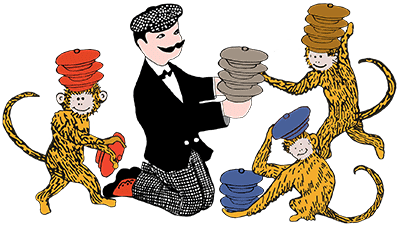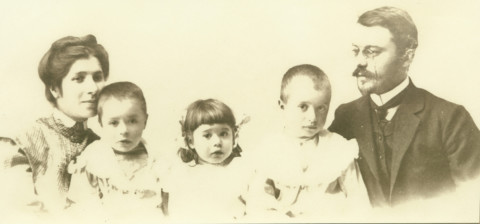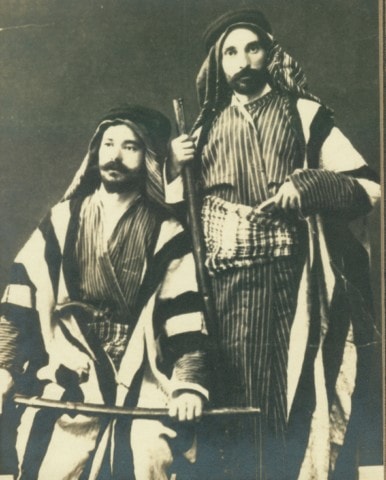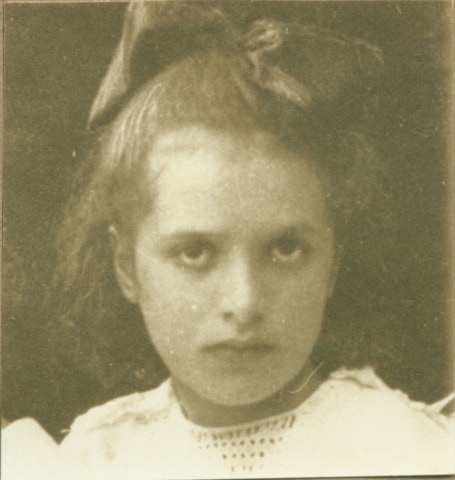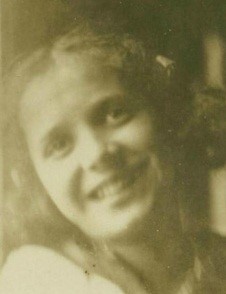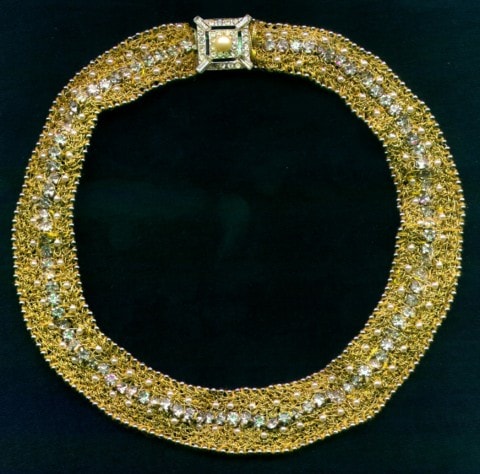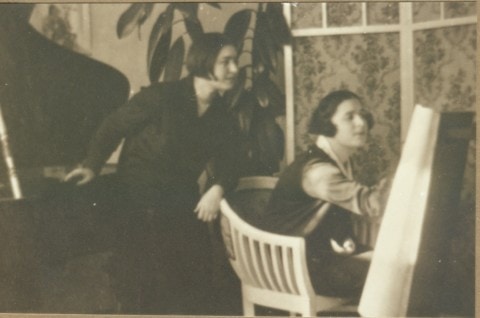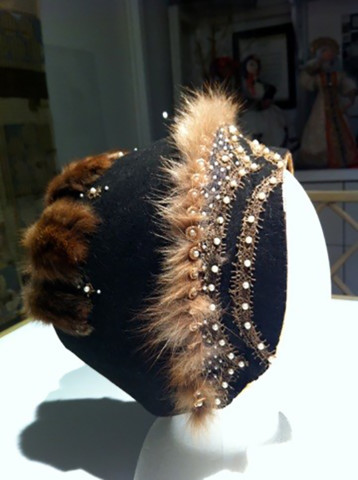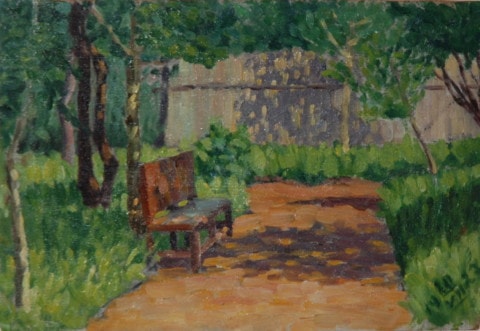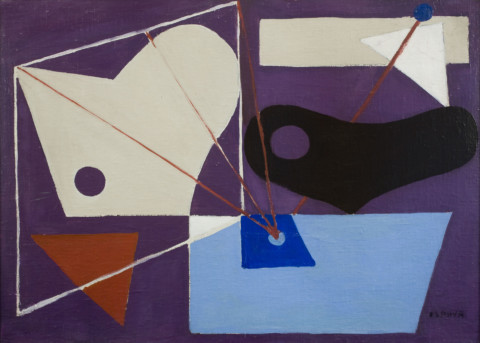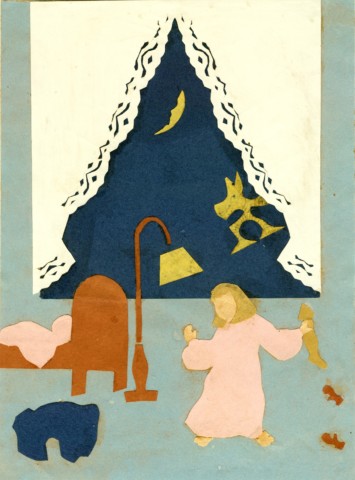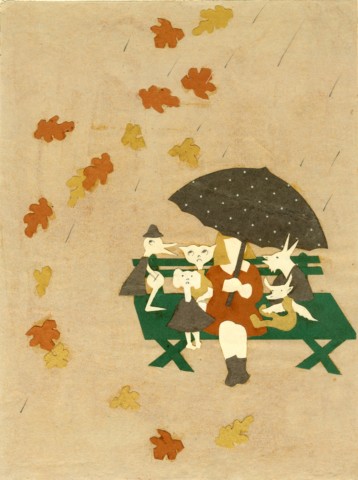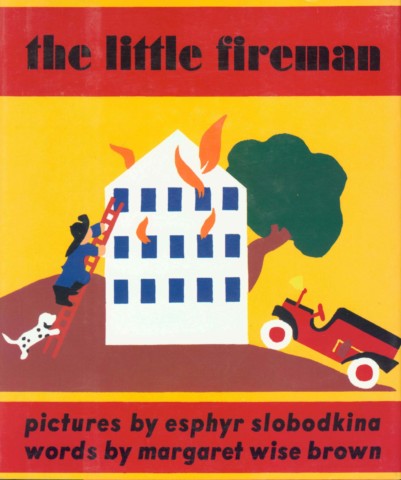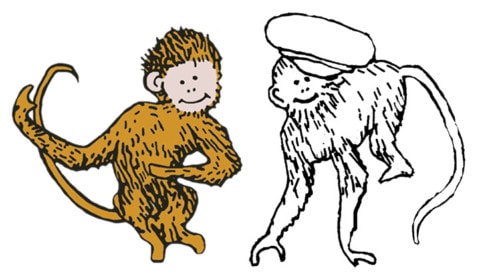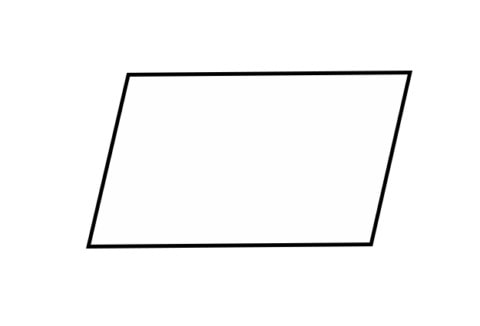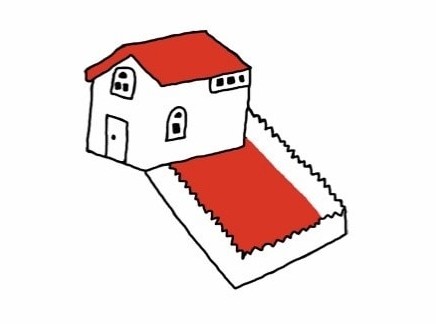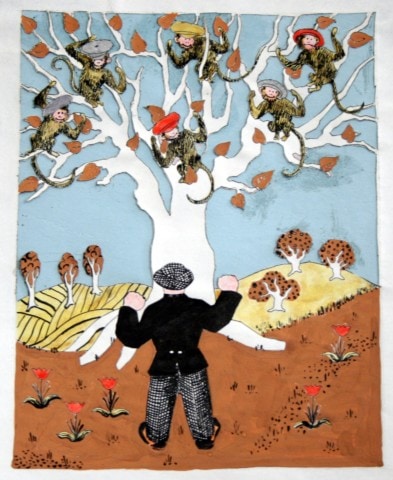The Story of Esphyr Slobodkina and Caps for Sale
Derived from Slobodkina’s memoirs: “Notes for A Biographer”
This is the story of how Esphyr Slobodkina, who grew up observing and remembering, learned to use her imagination to affect millions of people through art.
Esphyr Slobodkina was born in Russia many years ago. She had a loving mother and father, a sister and two brothers. She was the youngest child.
When Esphyr was five years old she became sick for a very long time. The illness was contagious. Esphyr was quarantined from her friends and siblings. She spent weeks in bed. During this time Esphyr’s brother died of scarlet fever. Her mother, also very ill, had to go away for a while. Her father worked all day and sometimes evenings. Esphyr was very sick, very sad, and very lonely.
Karabajak, a peddler who travelled all over selling religious objects, came upon Esphyr’s family at this heartbreaking time. Karabajak thought about how he might help the Slobodkin family. He did not turn his back and go looking for a happier situation. He knew Esphyr’s father and that he was a good man. And so Karabajak the peddler, stayed in the town to assist Mr. Slobodkin however he could.
While Karabajak helped at the Slobodkin house Esphyr’s loneliness and illness got him thinking what he might do to cheer her up. He found a box of Christmas decorations left over from a good deed the Slobodkin family had done years before. Karabajak strung a thin cord from the headboard to the footboard of Esphyr’s sickbed; from the footboard to the door jamb; from the door jamb to the other door jamb and finally to the top of the bookshelves.
Orange goldfish, smiling faces of little angels, fringe, Victorian glass beads, stars, cones and balls of shining brilliant colors — all bounced, swam and shimmered around Esphyr. She eyed this simple string of color combinations and forms. Many afternoons and evenings she fell asleep slightly hypnotized by the swaying motion of the hanging shapes.
Esphyr was quite young, but she would always remember how happy she felt looking at those decorations. She would never forget Karabajak and the gift his kindness brought.
After Esphyr recovered from scarlet fever, she was still sick often and alone a lot. And keeping up with her brother and sister was much harder than it used to be.
Here is a story remembered from childhood, which Esphyr wrote in her journal:
One rainy morning I found myself in the dining room alone with Mother. The rest of the children must have gone to school. I remember standing, my elbows on the far end of the sewing machine, my nose practically touching the revolving wheel, and drawling…,
“Mama, I am bored.” Mama pays no attention. I look at the rain-streaked window panes and begin again: “Mama, it is so boring…” Mama continues to sew a long, straight seam. “Mama, I am so bored…” Suddenly, Mama — my Mama who never, ever raised her voice in my whole life, turned briskly…”Bored!? She bellowed. “Nonsense! Go find something to do and you’ll soon stop being bored!” she roared in her magnificent mezzo-soprano voice. I am stunned but I obey. I find something to do and boredom is gone; not only for that day, but forever.
Never in my life have I been bored again. And if ever boredom threatens to appear, I quickly find something to keep my hands busy and it invariably variably disappears.
Esphyr Slobodkina, Notes for A Biographer, vol. I (Great Neck, NY: Urquhart-Slobodkina, 1980), page 86.
Esphyr was told to find something to do and she did. The day was rainy. Perhaps she could brighten it and please her mother, too, she thought. She thought of what Karabajak the peddler had done to cheer her. Beautiful colors danced in her memory and soon she had an idea.
From newspapers, magazines and scrap paper, she began to cut squares and triangles, circles and unusual forms that popped into her imagination. She even cut doll shapes. Did some of the shapes look like the decorations the peddler hung around her bed a few years ago?
Esphyr arranged the shapes on pieces of paper and when she liked the pictures she created, she glued each down. Sometimes she layered one shape over another. Sometimes she added bits of leaves or dried flowers, an old stamp or a button. Without knowing it, Esphyr was making collage. Over the next few months, she often gave the finished works to friends and family members as gifts.
Eventually, Esphyr got strong enough to play outside with her sister, brother and friends. She promptly forgot all about the collages.
In grammar and high school Esphyr Slobodkina had some special teachers who delighted in helping answer her questions. It was then that she began a lifelong love of art.
Through family time this love of art was groomed. Because of war, Esphyr’s family had become very poor, but they went to free concerts, the minor ballet, and local dances when they could.
Although Esphyr lived far from museums, she read about famous artists and looked at their work in books and magazines. Esphyr learned to love art in all its variations. She constantly observed how people decorated stages and costumes for plays; how they danced and sang. She studied the different shapes of buildings and churches and statues people designed.
On walks to school, on weekends, even when Esphyr was doing homework, she noticed how everything around her was made and arranged; the lines on the telephone poles that crossed in front of the clouds, the shapes of houses and windows, cracks in the sidewalk, the curve of a twisted branch.
In order to help the family make enough money to eat, Esphyr’s mother, who worked as a seamstress, taught her how to sew. After school Esphyr assisted her.
The many colors and shapes Esphyr had stored in her mind inspired her imagination.
She developed unusual designs to decorate and trim lady’s outfits. Esphyr’s mother was so pleased she allowed Esphyr to include her ideas in her work every day. The ladies who came to the shop complimented Esphyr on her new and different trim styles.
From age 12 to age 18, Esphyr’s job (work she relished much more than sewing) was to adorn all the lady’s clothing with beads, sequins, ribbons and other trim.
When Esphyr was 19 she traveled to the United States with money her brother and parents had saved so that she could study art in America.
While attending school Esphyr needed to earn her own money. She worked many jobs- painting lampshades, making pillows to sell and clothing for friends and relatives. She combined different types of cloth, and always experimenting with color. But times were hard and most people had no money for fancy things. This work did not pay very well.
Although Esphyr learned to paint traditionally, she preferred painting in the new abstract style. Painting abstractly allowed Esphyr to further explore color and shape.
In the evenings, after school and work, Esphyr met with other artists. They exchanged ideas and critiqued each other’s work. It was at this time Esphyr decided to be a professional artist. When Esphyr graduated from school, she continued to work and paint, and work and paint.
Esphyr and her artist friends began showing their artwork together. They made posters advertising their exhibitions and invited everyone to come. They called the newspapers and asked that these shows be included in their art sections. Little by little Esphyr Slobodkina’s paintings began to be noticed and appreciated by the public. But selling paintings is not an easy business. Esphyr continued to work and paint, and work and paint.
She always had plenty of ideas and was certainly never bored. But she was poor and in need of money.
One day a friend told Esphyr about a successful woman who wrote children’s books. Margaret Wise Brown needed someone to illustrate the many stories she was writing. (The author Margaret Wise Brown wrote Goodnight Moon and many other stories).
Esphyr wanted that job. But she had been studying painting and making sculpture. What could she do to make an illustration? She wished to present something that was new and unexpected.
In order to present illustrations, Esphyr needed to write a simple story. After a few days of contemplating ideas Esphyr thought about a little girl she knew and liked, named Mary. Mary used her imagination very well, too. She said strange things – she invented imaginary creatures called, “the Poodies.”
Esphyr would write a story about her little friend Mary and Mary’s “Poodies”.
Esphyr worked out in her mind’s eye how “the Poodies” would look and the story would flow. Then she drew Mary and went about writing.
Using any color and shape she desired, Esphyr drew, cut out, traced and copied all the pieces for her pictures. For the background of each page she used colored paper: an apple-green background signified spring; pale gray for a rainy fall day; sandy beige for the sunny beach scene; and deep blue for the night sky outside of Mary’s window.
Esphyr took scraps from everything she had at home. From a store purchase she recycled gray paper bags with tiny polka dots. These were cut into furniture shapes.
She used bits of paper with different patterns for the people, umbrella and objects in the scenes. She then pasted and layered the pieces on the background paper. When she was finished Esphyr had her first book made using the collage technique.
Margaret Wise Brown liked Esphyr’s illustrations. No one in America was using collage to illustrate storybooks. The pictures were new and interesting.
Although Esphyr was not able to get “Mary and the Poodies” published, Ms. Brown hired Esphyr to illustrate many other books.
Esphyr’s first book illustrated for Ms. Brown became an instant success. The story called The Little Fireman (1939) is considered the first published American children’s book made using collage. Esphyr illustrated many books for Ms. Brown.
Esphyr remembered a story her cousin had heard being told in her son’s classroom about a traveling peddler and monkeys. Esphyr tried to find the story in the New York Public library and elsewhere, too. After two years of searching she found nothing written about the story.
One day she decided to write the story her own way. That day she realized she had been thinking about the tale for so long she knew exactly how her version would be told. She wrote it down just as she imagined it. Then she began to think about the pictures. She wanted to use bright happy colors. Once again she recalled childhood memories of Karabajack the peddler, the Christmas ornaments, making collage, working in her mother’s shop, and all the things she learned in school.
Esphyr Slobodkina drew a tree and cut it out. She traced the tree and cut out many copies. She drew 16 different monkeys in a variety of poses. She traced and cut these, too. She colored each group of similar monkeys the same way.
Esphyr wanted to add something special to her pictures- abstract art, the same style she had employed when making illustrations for “The Little Fireman”.
Esphyr cut parallelogram shapes for roof tops out of red paper, and out of white paper she cut strips with triangle tops that would serve as houses.
She drew squiggly patterns for bushes and hills. She traced and cut these. When the shapes were apart, they looked nothing like hills or farmlands or houses. When put together they looked very much like what Esphyr intended. In fact, if you look at the different illustrations of Caps for Sale, you can see house and backyard shapes that are really unusual.
Esphyr’s mind’s eye visualized how each collage would come together.
She drew shapes for parts of flowers and trees out of brown, green, and tan paper, placing the little pieces in separate piles until it was time to lay them out. Part of each picture was drawn, and part of it was made from glued down shapes (collage).
Esphyr drew her peddler, traced and cut him out in pieces so his poses could change. And, she cut out caps in groups of four, and separately, making many copies.
Esphyr began to create each scene using light blue paper for the background. When she finished the pages were placed side by side. Esphyr looked at them for many days. Sometimes she moved a monkey, sometimes a flower or the peddler. The tree almost always stayed in the middle.
When every page looked its best, Esphyr sketched a drawing of how the first page looked. She moved all the pieces off that page and carefully began pasting the background, then the next layer, and the next layer, always referring to the sketch she made. It took a long time, but Esphyr new the importance of being patient and careful. She repeated this process for every illustration.
When the book was completed Esphyr took the finished product to her friend Margaret. Margaret Wise Brown loved it. She even helped name the story. Caps for Sale was published in 1940. It was a big success. It is now a children’s classic and has been translated into more than 12 languages over the years.
Esphyr became a very successful artist. She wrote 22 children’s books and her paintings, sculptures, and collages can be found in major museums around the United States.
In the 1960s Esphyr Slobodkina began work on the continuing story of the Peddler. Pezzo the Peddler and The Circus Elephant (renamed Circus Caps for Sale in 2000), is considered a prequel to the Peddler’s encounters with the monkeys.
In 1998 Esphyr began working on new versions of her many children’s books with Ann Marie Sayer who became her friend and writing companion. Esphyr asked Ann Marie to help her keep her story books and all the many characters alive for future children to enjoy.
Today, thanks to all the notes and drawings that Esphyr Slobodkina left for Ann Marie the Caps for Sale series continues with More Caps for Sale and Caps for Sale & the Mindful Monkeys.
Esphyr Slobodkina was always busy, paying close attention to the world around her. She never forgot how important it was to see the bright and colorful side of everything she experienced. Esphyr was thankful she had always worked at remembering what she learned in school, (some of which didn’t even seem important at the time).
And of course, she was grateful for Karabajak, the travelling peddler, who had transformed her sickroom with colorful decorations during a very sad time in her life. The kindness of Karabajak the peddler, one of Esphyr’s earliest memories, might have started it all.
